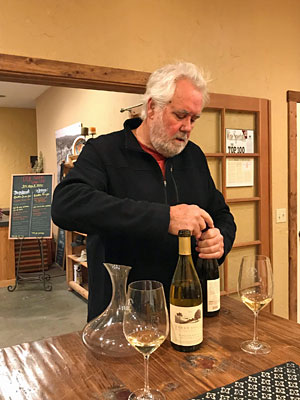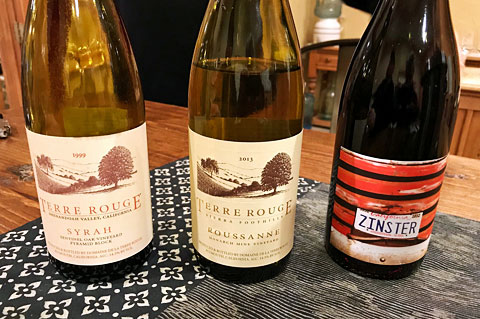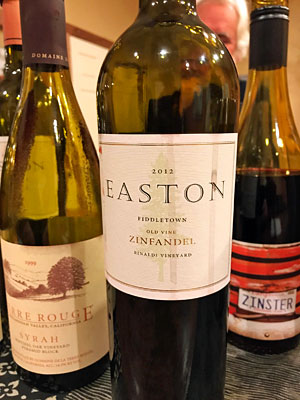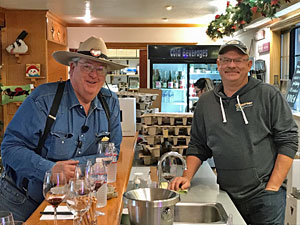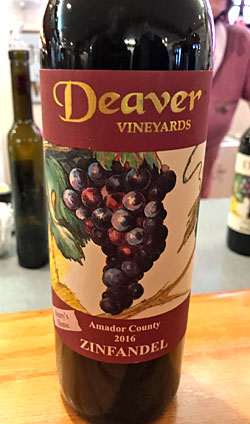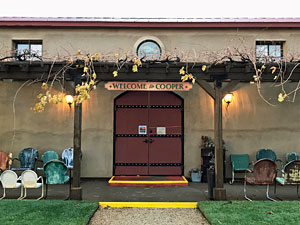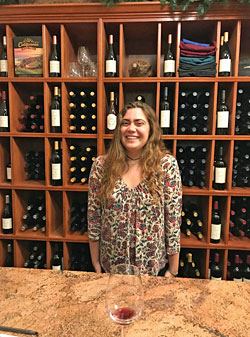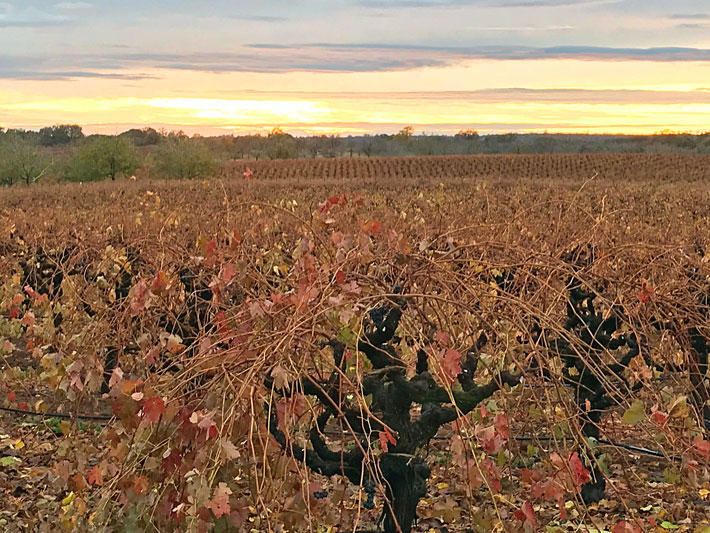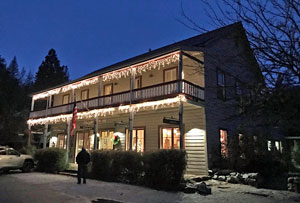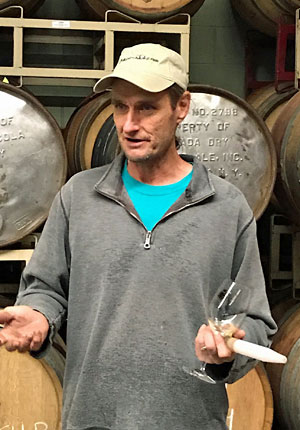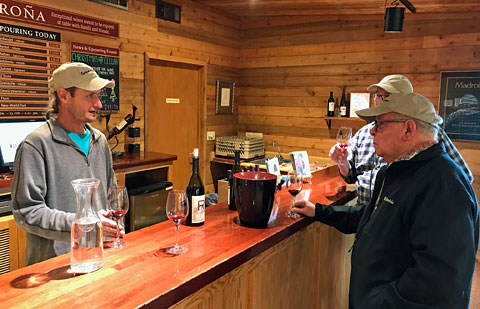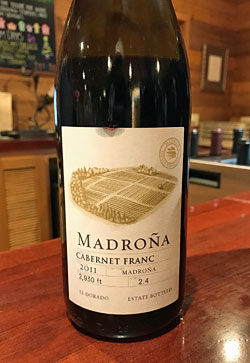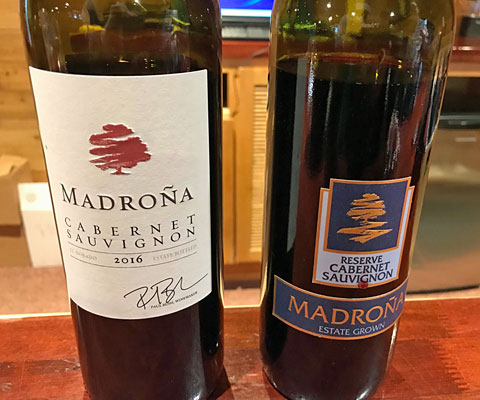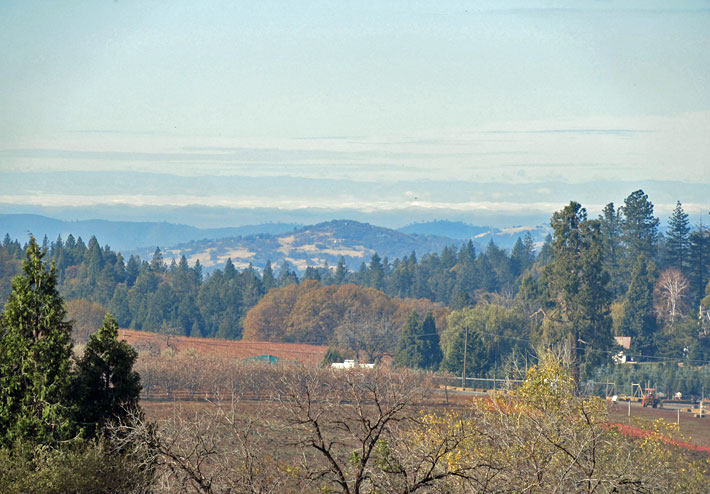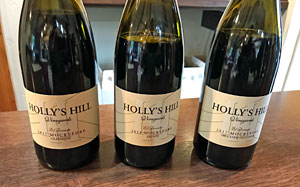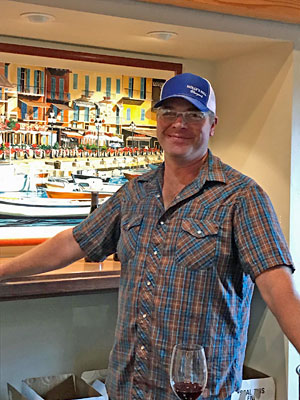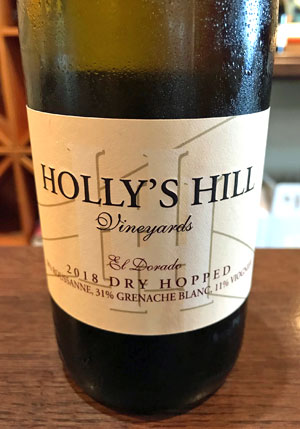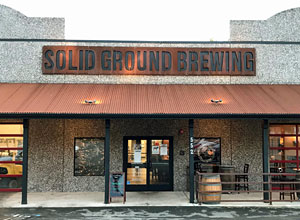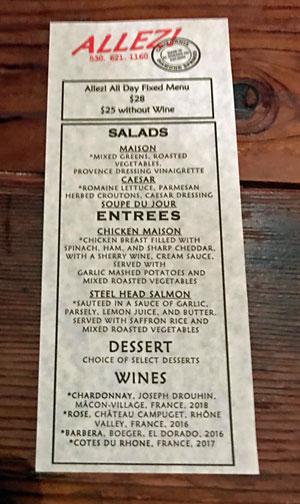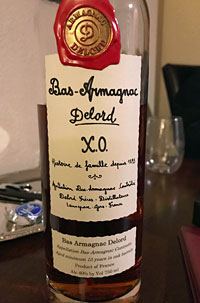Sierra Foothills Visits - December 2019 - Part 2
Eric, Michael, and I managed to stop at no fewer than six wineries in El Dorado and Amador County wine country on the first day of our Sierra Foothills wine tour. The next two days would be taken at a more relaxed pace. We met up on Monday morning in the small breakfast area right off the lobby of the Shenandoah Inn. The breakfast options there were limited but we didn’t need anything fancy so what was there fit the bill just fine. Eric volunteered to drive once again, and we all got ready to head out on the road for our second day of wine tasting – little did we know that we had quite an adventure to come later in the day!
| Monday
- December 2, 2019 |
Terre Rouge & Easton Wines
I was able to arrange an early visit with Bill Easton of Terre Rouge & Easton Wines on Monday morning. I’ve enjoyed the wines from both labels for many years but hadn’t been to the tasting room since 2012. Eric, Michael, and I got to the winery tasting room a few minutes early, but Bill soon arrived and welcomed us in. Bill has been around the Amador wine scene for many years, establishing his winery there in 1985. Prior to that, he owned and ran the well-known Solano Cellars wine shop in Berkeley that he opened in 1978. Bill’s wife Jane is a noted cook (and cookbook author), and created a menu for the Solano Cellars wine bar – the first wine bar in the East Bay.
At Solano Cellars, Bill looked to carry fine wines from small and lesser-known California and Pacific Northwest vintners, and he also became more interested in European wines, particularly French, Spanish, Portuguese, and Italian. When the time came to search for property to start his own winery, his goal was to produce balanced and structured “Euro-style” wines. Bill noted that in the mid-1980s, the expression of terroir was not yet a common goal for California wines, and he felt that the Sierra Foothills fit the bill for him with its Mediterranean climate and its volcanic and granitic soils. He feels that these aspects of the region lend more acidity, minerality, and structure to wines than is the case in many other California growing areas. In addition to the winery and surrounding vineyards that Bill farms in Shenandoah Valley, he and Jane also own a 24-acre site in the Fiddletown area.
Bill and Jane’s winery produces wine for two labels. One label is Terre Rouge – meaning “red earth” in French, this is a reference to the reddish granitic and volcanic soil common to the area, the color due to iron oxide and cinnabar. Terre Rouge focuses entirely on wines made from Rhône grape varieties. Wines released under the Easton label are made from well-known California varieties, mostly Sauvignon Blanc, Zinfandel, Barbera, and Cabernet Sauvignon. From his many years in the Sierra Foothills, Bill has long-established fruit sources in Placer, El Dorado, Amador, and Calaveras counties for his wines, from sites up to 3,200 feet in elevation. He noted that he assisted with the development of some of these vineyards, and he’s able to have exclusive use of the fruit from these sites. Bill typically makes as many as 25 different wines each year, most of which are small-production bottlings. The Terre Rouge & Easton labels together produce a total of around 20,000 cases annually.
Bill led us back to a table in the winery’s VIP room (since Eric in particular is Very Important!) around the corner from the main tasting bar. He had selected three bottles for us to taste since he knew that we had somewhat limited time that morning. He started out by pouring us the Terre Rouge 2013 Monarch Mine Vineyard Roussanne, from a vineyard east of Auburn in Placer County at about 2,400-foot elevation. He noted that he was given the budwood for the Roussanne vines by famed Rhône Valley vintner Jean-Louis Chave. Fresh pear and citrus aromas, with medium body balanced by bright acidity, and a long clean finish.
Next up was the Easton 2018 “Zinster” Zinfandel, Lot 1852. “Zinster” is a new project for Bill – this is just the second vintage – that celebrates Zinfandel’s arrival in California in 1852. The fruit came from the estate vineyard in Fiddletown, planted in 1999 and head trained, using heritage Zin selections. Bill’s goal is to make the wine as it might have been made in the 1850s without most modern winemaking equipment – for example, it’s fermented using whole clusters rather than destemmed fruit. Bill told us that he’s aiming for a lighter style of Zinfandel with the “Zinster,” similar to Cru Beaujolais or a new wave Spanish Grenache. This was indeed a lighter Zin, with fresh berry aromas along with earth, herbs, plus floral and savory undertones, medium weight, and a lively texture and finish.
Since our tasting was moving right along, Bill stepped over to the tasting bar and brought back a few bottles from there. There are generally five different Zinfandel bottlings under the Easton label, and we tasted two more of them. The Easton 2015 Amador County Zinfandel is a blend from various vineyard sources in the area, with vine ages of 20 to 80 years. Bolder and darker fruit character than the “Zinster” bottling, spice, a bit richer mouthfeel, and more grip on the finish. Bill noted something that helps set his Zinfandels apart from most others in the Sierra Foothills – they’re all aged in French oak rather than American (Bill ages all of his wines entirely in French oak). Bill next poured us the Easton 2012 Rinaldi Vineyard Old Vine Zinfandel, sourced from one of California’s oldest vineyards. Formerly known as Eschen Vineyard, this site just outside Fiddletown has Zin vines that may date back as far as 1865. This featured savory and slightly smoky aromas along with brambly wild berry fruit, spice, and a hint of pepper, great structure, finishing with fine tannins.
We switched back to Rhône varieties for the rest of our tasting with Bill, beginning with the Terre Rouge 2011 “L'Autre,” a blend of 65% Grenache, 20% Mourvèdre, and 15% Syrah. The fruit was sourced from vineyards in Placer and El Dorado counties. This had floral and earthy notes to go with red fruit and spice, medium weight, and a lively finish. A 2011 vintage wine is unusual for most wineries as a current release, but since many of Bill’s wines are structured for aging, he prefers to hold these back until he feels they’re ready to drink rather than releasing them right away when they may not be showing their full potential. Another example of this was the Terre Rouge 2012 Mourvèdre that we tasted next. Showing earth, plum, smoke, and iron, with fine structure and moderate tannins, this can still be cellared for further development. Bill poured us one more current release wine, the Terre Rouge 2012 DTR Ranch Syrah, with fruit sourced from his estate vineyard in Fiddletown. The Syrah vines there were planted in 1999 and are mostly own-rooted. Savory aromas of smoked meat, dried herbs, and dark berry fruit, this had a richer mouthfeel than the previous wine with plenty of structure and firm tannins for further aging.
An older library wine was the third bottle that Bill had selected for us earlier, and we finished our tasting with it – the Terre Rouge 1999 Sentinel Oak Vineyard Pyramid Block Syrah. Located in Shenandoah Valley not far from the winery, Sentinel Oak is the one of the oldest Syrah vineyards in the Sierra Foothills, first planted in the early 1980s with own-rooted Syrah UCD-1, a Hermitage selection that was originally brought to California via Australia. This older Syrah that Bill poured for us was a highlight, demonstrating how well his wines can age. Plum and darker berry fruit, bacon, spice, herbs, and earth on the nose, a lively texture and still showing good structure, with nicely-resolved tannins on the long finish.
In addition to the wines we tasted on this visit, Terre Rouge & Easton produce a wide variety of other bottlings, including Sauvignon Blanc, Viognier, Grenache Blanc, “Enigma” white Rhône-style blend, a Grenache and Mourvèdre-based Vin Gris, Pinot Noir, Barbera, more Zinfandel bottlings, Cabernet Franc, Cabernet Sauvignon, “Tête-à-Tête” red Rhône-style blend, additional Syrah bottlings including the top-of-the-line “Ascent,” plus a couple of sweet wines.
Eric, Michael, and I really appreciated Bill seeing us so early the morning we visited. He was an engaging host as always, and very generous in opening the older Syrah for us to taste. Bill’s Terre Rouge label has been leading the way for Amador County Rhône-style wines for over 30 years, and his Easton wines – particularly the Zinfandels – have been among the best from the region. My favorites from our tasting with Bill included the 2013 Roussanne, 2018 “Zinster,” 2012 Rinaldi Vineyard Zinfandel, and 1999 Sentinel Oak Pyramid Block Syrah, while the 2012 Mourvèdre and 2012 DTR Ranch Syrah could easily be in that list as well. Bill’s wines have great structure and tend to age more gracefully than many others from Amador County. You’ll definitely find distinctive wines that stand out from most in the area when tasting at Terre Rouge & Easton – I’d consider it a “must” stop in Shenandoah Valley.
Deaver Vineyards
Our next winery destination was only a few minutes away, along Steiner Road in the heart of Shenandoah Valley. I’d visited Deaver Vineyards earlier in the year but I thought it would be worth a return there, since I knew that Eric and Michael would enjoy meeting winery owner Ken Deaver. We walked from the parking area through a light rain and into the tasting room, where we were welcomed by Linda, who was behind the long wood tasting bar. Since Ken was running a few minutes late, Linda offered to start us off on tasting a few wines – needless to say, we took her up on that! But before too long, Ken arrived and greeted us. Dressed as always in his trademark denim shirt and jeans and a big wide-brimmed hat, Ken is a true Amador County original, and his roots in the region run as deep as anyone there.
Both of Ken’s great-grandfathers – Jacob Clark Deaver and John James Davis – had settled in Shenandoah Valley in the 1850s. Davis planted Mission grapes there, not too far from the current Deaver tasting room. I was able to see those old Mission vines, believed to date from as early as 1853 or 1854, during my earlier visit. These are thought to be the oldest continuously-producing winegrape vines in California. The two families merged in 1927, and Ken’s father (also named Ken) farmed the ranches of the now-combined Deaver and Davis families. Ken established the Deaver wine label in 1986, and the tasting room opened in 1990. His wife Barbara (“Bobbie”) opened the adjacent Amador Harvest Inn bed-and-breakfast not long afterwards. The elder Ken Deaver passed away in 1989, and Bobbie passed away in 2009. The younger Ken still farms about 500 acres total – grapes, pumpkins, pasture for cattle, sheep, and goats – and he oversees the wine business as well. Ken and his wife Jeanne manage the tasting room and the Amador Harvest Inn. Jeanne also runs the Amador Flower Farm not far away, growing nearly 1,200 varieties of daylilies there. Ken told us that it looks like one of his children will be taking over when he’s ready to retire, and the grandchildren may well be continuing the family tradition as well.
In addition to the old Mission vines that Ken farms, he also has some very old Zinfandel vines, which may date back to the 1860s. Cuttings from the early Deaver Zinfandel plantings have been used to start many other Zin vineyards in Amador County, and there is now a recognized Deaver clone of Zinfandel. Overall, Ken farms about 250 acres of vineyards, planted largely to Zinfandel, as well as Mission, Primitivo, Petite Sirah, Sangiovese, and Alicante Bouschet. Only a small amount of this fruit goes into the Deaver wines, with around 95% of it being sold to other producers. Nearly all of the Deaver wines are sourced from the Sierra Foothills fruit, much of it from the vineyards that Ken farms. Ken mentioned that most of the fruit he buys from other growers comes from vineyards less than 10 miles away. Current production of Deaver’s own label is about 3,000 cases. Ken is first and foremost a farmer and rancher rather than a winemaker, and most of the Deaver wines are made offsite – many of them are made by noted vintner Marco Cappelli. In addition to quite a few white and red table wines, Deaver also makes several sparkling wines and an array of Port-style wines, including Mission Angelica.
Linda started out our tasting with the NV “Deaver’s Blend” – inspired by Chianti, the blend changes from one release to another, and the current one is 68% Sangiovese, 20% Zinfandel, and 12% Barbera. With bright and ripe black cherry fruit along with spice notes, medium-bodied with milder tannins, this should be a good everyday drinker. We followed this with the 2016 Alicante Bouschet – this displayed a riper and bolder dark fruit character plus earth and spice, with a richer texture and finish. The 2016 Barbera had plum and black cherry fruit, nice acidity on the palate, and bright finish. We also tasted the 2017 Pinot Noir, with fruit sourced from the Fair Play region of southern El Dorado County. Earthy red fruit with medium-light weight on the palate, this is a lighter style of Pinot.
After Ken arrived at the tasting room – joined shortly afterwards by Deaver operations manager Brad Dehn, whom I’d also met during my earlier visit – we switched to Zinfandel, the variety that the winery is probably best-known for. The 2016 “Old Vines Circa 1860s” Zinfandel was sourced from the old-vine estate vineyard fruit. This had ripe boysenberry fruit, notes of earth and spice, a rich texture, and a sweet fruit character on the finish. Next was the 2016 “Henry’s House” Zinfandel – from 100+ year-old vines, the wine’s name is a reference to early Amador settler Henry Modani. Spicy and peppery blue fruit, this had more structure on the palate than the previous wine, finishing with moderate tannins.
We continued with more Zin bottlings. The 2016 “Ten Zin” Zinfandel comes from a block at Deaver Vineyard that was established in 1998 with cuttings of heritage vines from ten old-vine Sierra Foothills sites. Featuring riper and bolder fruit than the two previous Zins, this had a darker berry character with a rich mouthfeel and finish. From a just-opened bottle, the “Ten Zin” seemed a bit on the simple side compared with the very good 2015 vintage I’d tasted earlier in the year and might have benefited from more aeration, or perhaps just a bit more bottle age. Our final Zin was a pre-release bottle of 2017 “Deaver Signature” Zinfandel, my favorite of the four Zins we tasted. This comes entirely from estate fruit, from a blend of different vineyard blocks. With a lighter color and more brambly, earthy, and savory qualities along with plenty of black cherry and plum fruit, this had a lively mouthfeel and finish. We finished up our tasting with the 2016 Petite Sirah – dark berry fruit with savory herbal notes, a mouthfilling texture, and surprisingly tame tannins. In addition to the wines we tasted and their sparkling and Port-style wines, other recent Deaver releases have included Zinfandel Rosé, Pinot Noir, Sangiovese, Primitivo, Cabernet Sauvignon, and Orange Muscat.
I usually don’t make two visits in seven months to the same winery but I made an exception with Deaver and was glad that I did. Ken is so much fun to talk with, and Brad and the tasting room staff did a great job of pouring us a good selection of the Deaver wines to taste. It was interesting to compare my impressions of the wines we tasted there in May to the ones we tried in December – in many cases they were new vintages this time. Highlights for me included the 2016 “Henry’s House” Zinfandel, pre-release 2017 “Deaver Signature” Zinfandel, and 2016 Petite Sirah, and the NV “Deaver’s Blend” may have been the best “Wednesday pizza wine” we tasted on our trip. Though Ken may not be at the tasting room when you visit, that should not stop you from checking out the Deaver wines when you’re in Amador wine country.
Since we hadn’t brought along any sandwiches for lunch on this day – the weather forecast didn’t look promising for a picnic – we asked the tasting room folks at Deaver where they recommended we stop in for lunch. They mentioned a couple of options but they all seemed to agree that we’d find the best food at The Kitchen at Helwig Winery, not far away. We drove up to the winery and located the place where we needed to order our food. The menu features burgers, sandwiches, wraps, salads, a couple of sides, and a charcuterie platter. I got the Nashville Hot Chicken Wrap – smoked chicken with a cabbage / dill pickle blend, and Nashville aioli in a tortilla, served with fries. My wrap was very tasty if a bit messy to eat, while the fries were especially good. We were running a bit short of time after enjoying a relaxing lunch at Helwig, so we didn’t stop in at the tasting room there. Instead, we made our way through a harder rain to Eric’s car, then drove a couple of miles to our next winery appointment of the day.
Cooper Vineyards
We made one more winery stop on Monday, at Cooper Vineyards. I’d stopped in there briefly over a dozen years earlier but hadn’t been back since then, so I was long overdue for a return visit. We had made an appointment to see Mike Roser, the Cooper winemaker, and after checking in at their tasting room we were directed to meet Mike at the winery building a short distance down the hill. We parked in front of a large steel building, and the “Michael Roser Winemaker” sign over the door told us immediately that we were in the right place! Mike came out to greet us and led us inside and back to his office / lab in a corner of the winery.
The Cooper family has been farming land in Shenandoah Valley for many years, and their current farming and winemaking business – headed up by Dick Cooper – spans several generations of the family. Over the years, the Cooper family mainly grew prunes and walnuts, and tended a lot of pasture land for grazing. Though they had once grown some Zinfandel, by the late 1970s they no longer grew grapes, but Dick felt the time was right to plant grapevines again. Although we didn’t have the opportunity to visit with Dick, he has relayed a great story of how Cooper Vineyards first planted Barbera, a variety that has become one Cooper’s – and Amador’s County’s – most highly-acclaimed grape varieties. Dick’s parents had well-known Sacramento grocer and wine merchant Darrell Corti over for dinner at their house one evening, and Dick’s father Hank asked Darrell what grape varieties he recommended if they went ahead with planting a vineyard on their property. Darrell told them that they should plant Barbera and Dolcetto. Since these Italian varieties were ones that the Coopers were not familiar with, Hank asked Darrell to write them down for him, and not finding a piece of paper handy, Darrell took out a dollar bill from his wallet, wrote “Barbera” and “Dolcetto” on it, and gave it to Hank. The dollar bill that helped put Amador County Barbera on the map is now on display at the Cooper tasting room.
Although they weren’t able to find any Dolcetto cuttings, they did track down Barbera from nearby Monteviña Winery, and planted five acres of vines in the late 1970s. It took time for demand for that variety to grow, but vintners including Scott Harvey and Bill Easton began making very good wines from the Coopers’ Barbera fruit and things took off from there. For years, the family did not make any wine themselves and only sold their fruit to various vintners, but in 1999 Dick launched the Cooper label for their own wines. Their winery and tasting room buildings were completed in the mid-2000s, and a new case storage facility is currently under construction. Today the vineyard has grown to about 100 acres in size – there’s an additional 60 acres of walnuts and olives – with about 30 acres of Barbera plus 16 other varieties planted there. The Coopers sell around 60% of their fruit to other producers (15-20 others get their Barbera fruit), and generally make between 7,000 to 10,000 cases of their own wine each year. They produce about 25 different bottlings, with Barbera being the largest production wine at about 2,400 cases. Most of the wine is sold direct to consumer – Cooper has a big wine club and hosts four large events for the club each year.
Mike, who has been the winemaker at Cooper from the start, told us a little about his background. He trained as a chef in the 1970s, and created food pairings at Windwalker Vineyard in the Fair Play region of El Dorado County before eventually becoming their assistant winemaker. He also worked at nearby wineries Fitzpatrick and Fleur de Lys before heading a few miles south to Amador County to head up the Cooper winemaking. We couldn’t help noticing Mike’s brightly-colored “Rock & Roll Sounds of Wasted Space” shirt while we talked, and we discovered that he’s also a guitarist in that band. Mike told us that the 2019 vintage at Cooper was very good quality, with few issues during the growing season, a view he said is shared by nearly all of the vintners in the area. He did talk about the difficulties during harvest and crush of dealing with power shut-offs by the PG&E utility company – they temporarily shut off power several times during autumn in many parts of northern California to help avoid having their equipment spark a wildfire, something that’s happened a number of times in recent years. Mike said that they managed to deal with the power issues without any serious problems but of course it made things more difficult.
Mike talked with us about his winemaking. Some of the white varieties are whole-cluster pressed but they’re generally destemmed prior to pressing. All of the red fruit is destemmed but kept whole-berry and not crushed, then fermented in small bins with manual punchdowns. Mike wants to make low-tech, hand-crafted wines, so fermenting in bins follows that idea. Ideally, fermentations get six daily punchdowns, with a minimum of three, aiming for better extraction and fewer issues during fermentation as well as for better mouthfeel in the finished wines. Mike said that the higher-end wines always get six punchdowns per day and are aged in a higher percentage of new oak than their other wines. The Cooper facility has its own bottling line that can handle about 650 cases per day – we could see that they were getting ready for an upcoming bottling run.
After talking with Mike, he directed us to head back up the hill to the tasting room to taste some of the current Cooper releases. We walked up to the tasting bar in the large room, and the young woman behind the bar poured us the first wine. We soon learned that this was Dick Cooper’s granddaughter Rose, and that Dick’s four daughters are all involved in the family wine business as well. Mike came up to the tasting room and joined us for awhile as we tasted too. Our first wine was the 2018 “Roundpen Rosé,” a Grenache Rosé from Shenandoah Valley fruit. Light salmon-pink color, this featured fresh strawberry fruit along with notes of melon and flowers, vibrant acidity, and a crisp finish – my favorite rosé wine of our Foothills trip. We followed this with the 2018 Viognier, made in stainless steel – tropical fruit and floral aromas, and medium-light weight on the palate.
Switching over to reds, Rose poured us the 2017 Grenache – bright, spicy red fruit with a lighter texture. Next up was the 2016 Sangiovese, with raspberry, earth, and spice on the nose, good acidity, and fine tannins. Barbera is the wine that Cooper is best-known for, and the 2017 Barbera was our next wine. This displayed cherry and raspberry aromas plus notes of smoke and herbs, medium-bodied with juicy acidity and a tasty finish. Mike noted that he picks Barbera based on acidity rather than sugar, since it can take awhile for the high acids the variety is known for to drop sufficiently. He told us that there are usually two or three harvest days for the Barbera since it’s not all ready to pick at the same time, but it took four separate picks in 2019. One final red at the tasting room was the 2016 Primitivo “Riserva,” which was aged for 35 months in new American oak. With ripe plummy fruit, vanilla, smoke, and spice, this had a richer texture and firmer tannins, along with a stony mineral note on the finish. I should note that I opened a 2017 Alicante Bouschet a couple of weeks after our visit – bold, dark-fruited, and framed by sweet oak, with plenty of structure but surprisingly tame tannins.
Rose poured us one more wine to finish our tasting at Cooper, the 2017 “Dicembre.” This is a fortified late-harvest Zinfandel, with 17.7% alcohol and 4% residual sugar. Mike told us that the wine’s name came from an early vintage at Cooper when the winery buildings were still being complete, and one ton each of Zinfandel and Barbera came in very late, so the fermentation process went on into December that year. Mike vowed never to do that again but the winery has continued to produce a fortified late-harvest wine called “Dicembre” inspired by that first one. The wine showed spice, ripe dark berry fruit, and chocolate aromas, a rich texture and long, moderate sweet finish, a nice way to wrap up our tasting.
Other current and recent Cooper wines include Sauvignon Blanc, Roussanne, Carignane, Mourvèdre, Primitivo, Zinfandel, St. Peter’s Church Zinfandel (from the St. Peter’s Church clone of the variety), Alicante Bouschet, and Anniversary (red Rhône-style blend).
We had a great time visiting with both Mike and Rose. It was fun listening to Mike talk about the Cooper wines as well as about other subjects, and Rose was a delightful and high-spirited presence at the tasting room. My favorite wines of our tasting were the 2018 “Roundpen Rosé” and 2017 Barbera, with the 2018 Viognier and 2017 Dicembre not far behind. And although the 2016 Primitivo “Riserva” was a bigger wine than I typically prefer, it will appeal to fans of bold Zinfandels and similar wines. I’m glad that I finally made it back to Cooper after so many years, and I’ll be sure to stop in more often from now on. While they may be best-known for their Barbera, there are plenty of other tasty wines to check out at Cooper.
The late-afternoon light across the vineyards was beautiful as we left the Cooper tasting room. As we headed out of the driveway from Cooper and back onto Shenandoah School Road, we had no idea that we were about to embark on one of the craziest drives any of us had experienced on a Grape-Nutz wine tour. Our destination was the Volcano Union Inn + Pub, located in the tiny Gold Rush-era town of Volcano. We’d all been to Volcano before, and I knew what I figured was the easiest way to get there – south along Highway 49 from Plymouth, then east on Highway 88 to Pine Grove, with Volcano just a short drive north from there. But of course the GPS in Eric’s car recommended a shorter (and theoretically faster) route east through Fiddletown and then approaching Volcano from the northwest. After a few, let’s say interesting, adventures using GPS navigation in the past, you’d think we might have learned our lesson, but no. The drive to Fiddletown was easy enough, but the rest was not. Much of the GPS-guided route was along a poorly-paved road that often narrowed to one lane wide and was hemmed in by trees on both sides. At one point we had to drive through a pretty good-sized stream that flowed across the road. And that was only after traveling for a couple of miles on an even narrower unpaved road! We could almost hear the dueling banjos from “Deliverance”…wait a minute, we actually did hear them, as Michael played the clip on his phone in the back seat.
Eventually, we did finally arrive in Volcano, just as it was getting dark. There’s never actually been a volcano there – the town is set in a bowl-like valley that early settlers mistakenly thought was a volcanic caldera. The quaint Volcano Union Inn was built in the 1880s as a boarding house and saloon, and now includes four bed-and-breakfast guest rooms in addition to the ground floor pub. We got to the pub on the early side and the dining area was not very crowded, but by 6pm or so it had really filled up. I ordered the Union Burger with a salad, and both were quite good. I had a local brew with my burger – an IPA from Amador Brewing – which completed a tasty dinner.
Needless to say, after we finished our meal we took the more straightforward route from Volcano back to Plymouth! Eric once again headed over to my room for an after-dinner drink, this time bringing a bottle of Eagle Rare 10 year Bourbon. While bourbon is not generally one of my favorite spirits, this one was quite nice.
On Tuesday morning we had another light breakfast at the Shenandoah Inn. Since the weather forecast for the day looked more promising than the past two days, we thought we’d order sandwiches from Amador Vintage Market again and hope for decent picnic conditions at lunchtime. Eric drove once again, and after picking up our sandwiches, we headed north along Highway 49 to Placerville in El Dorado County and through the Apple Hill area northeast of town toward our first winery appointment that day.
| Tuesday
- December 3, 2019 |
Madroña Vineyards
Our first Tuesday visit was at Madroña Vineyards, located on the eastern edge of the Placerville area’s Apple Hill – not surprisingly, this is home to many apple orchards, a number of which have farm stores open to the public. Madroña also is on the edge of the higher-elevation Camino area, and in fact their estate vineyard near the winery is at an elevation of about 3,000 feet. Eric, Michael, and I had an appointment with co-owner and winemaker Paul Bush. We were a few minutes early when we arrived at the tasting room, where staff members were getting ready to open up for the day, and they told us that Paul was still doing some preparatory work for a bottling the following day but would be up from the winery to see us shortly.
Madroña is one of El Dorado County’s pioneering post-Prohibition wineries. Not only are the vineyards among the first commercial plantings in the area following that period but the winery itself is also one of the earliest. Madroña was founded by Paul’s parents Dick and Leslie Bush, who began planting grapevines at their property in 1973. At the time it was planted, this was the highest-elevation vineyard in California. The first Madroña wines released were from the 1978 vintage. The winery building – now solar-powered – was completed in 1980, and houses the tasting room as well as the production facility. They have their own bottling line, which can handle up to 165 cases per hour.
Dick and Leslie have passed the reins of Madroña to Paul and his wife Maggie – Paul manages the vineyard as well as making the wines, while Maggie is the winery’s general manager. In addition to the 52-acre Madroña Vineyard, the winery works with two additional higher-elevation estate vineyards – Enyé and Sumu Kaw – planted in the mid-1990s and adjacent to one another in the Pleasant Valley area a few miles to the south. Paul’s brother and sister-in-law, David and Sheila Bush, own the Sumu Kaw property and Sheila manages the farming there. The three estate vineyards – all farmed organically – total nearly 90 acres, with 29 different grape varieties planted among them. In addition to winegrapes, the family grows walnuts, chestnuts, and Christmas trees. Paul heads up Madroña’s winemaking, and noted vintner Hugh Chappelle is the consulting winemaker, working with Paul mainly on blending decisions. Hugh is very familiar with Madroña’s fruit, as he was their winemaker from 1993-2000. Paul majored in macro-economics at UC Davis, and took the Introduction to Winemaking course while he was there. Paul’s father Dick made the early Madroña wines, and Paul told us that he reluctantly helped at the winery at first but gradually got hooked on it – he’s been making the wines there for the past 17 years. Total annual production is currently around 12,000 cases, most of it sold direct to consumer.
In addition to Madroña, Paul and Maggie have launched their own new winery, Rucksack Cellars. The name is a term for backpack that’s more familiar outside the US, and is meant to celebrate the notions of traveling, exploring, and especially enjoying the outdoors. The Rucksack wines are distinct from Madroña in that they’re not all made from estate-grown fruit, and they’re labeled with the broader Sierra Foothills appellation rather than El Dorado. Rucksack does have their own vineyard planted, and it includes Chenin Blanc and Cabernet Franc vines. The Rucksack tasting room, just across the road from Madroña, opened in the summer of 2016.
Paul joined us in the Madroña tasting room before long, and he led us outside so we could get a good overview of the adjacent vineyard while telling us more about the site. The property was a large open field when Paul’s parents bought it, with a large madrone tree near the center – the winery’s namesake tree is still there. He mentioned that when a local agricultural advisor first met with his father, he recommended growing Christmas trees and grapes – just what they planted there! Paul noted that madrone trees are widely considered to be indicator plants for a good place to grow grapes, as they need a moderate climate and well-drained soil. The topsoil at the vineyard is Aiken clay loam – there’s only about 30-36 inches of soil down to hardpan at the Rucksack site across the road while it’s deeper at the Madroña vineyard. It’s volcanic and acidic soil, and Paul feels that the low pH helps display varietal focus and elegance in the wines.
The original plantings at the vineyard were Zinfandel, Riesling, Chardonnay, Merlot, and Cabernet Sauvignon – some of the Zinfandel was later replaced with Cabernet Franc. Paul told us that although summers in the El Dorado region can be hot, there tends to be a long, cooler autumn growing season for grapes, allowing them to develop slowly without undue sugar accumulation. He said that their vines typically don’t require much irrigation, and they rely on overhead sprayers rather than drip lines for this. He’s very happy with the 2019 vintage, and feels that the fruit developed better maturity with lower alcohol this year.
Paul led us back into the winery, where he proceeded to pull a number of 2019 and 2018 barrel samples for us to taste. Since these are all still developing and not ready to bottle as is, I’ll just give a few brief impressions. We started with 2019 Riesling, tasted from a steel drum – bright and lemony, with mouthwatering acidity. Paul followed that with two Chardonnay samples, 2019 Wente Clone 4 Chardonnay and 2019 Clone 76 & 95 Chardonnay, each from older barrels. The Clone 4 had pear and herbal notes with a stony mineral quality while the Clone 76 & 95 had more of a citrus character with vibrant acidity. Paul noted that he often gets a citrus character from the white varieties grown at their vineyard. 2019 Moscato Giallo, from a steel drum, had subdued Muscat character, with floral and orangepeel aromas. 2019 Barbera Rosé displayed upfront red fruit with bright, juicy acidity.
Moving on to red barrel samples, Paul offered us tastes of three different Cabernet Francs. A sample of 2019 M Series Cabernet Franc was first – this will go into Madroña’s M Series wines (“M” for Paul’s wife Maggie). The “M” is for Paul’s wife Maggie, who created the M Series concept for Madroña and makes these wines. The fruit for the M Series – Riesling, Rosé, and Cabernet Franc – is picked earlier than usual, to capture more freshness and acidity as well as lower alcohol in the wines. This Cab Franc sample had bright savory, herbal aromas along with black cherry and darker fruit and a touch of smoke, and lively texture. Next was 2019 Rucksack Cabernet Franc, which featured more intense and fresh fruit along with herbal notes, richer texture and grippier tannins. The "regular" 2019 Madroña Cabernet Franc completed this trio – darker color and more reductive at this stage, this showed less fruit and more savory qualities, with a chewy tannic finish. Of course all of these need more barrel age before they’ll be ready to release!
We tried three more barrel samples with Paul. 2019 Nebbiolo – pressed at 8 brix to help balance the fruit and tannins – had red fruit and floral aromas, with a big but not aggressive tannic structure. 2018 Syrah was next, with lots of smoky bacon aromas plus dark fruit, spice, and a hint of black pepper, with chalky tannins. Our final barrel sample was 2018 Malbec / Merlot – Paul told us that this will most likely become part of a blend and will not be bottled on its own. Tobacco, smoke, and plum aromas with fine acidity and a stony mineral note, with broad tannins, the two varieties worked well together here.
Following our barrel tasting in the winery, we headed up the stairs and back into the tasting room to try some current releases from both Madroña and Rucksack. Paul also pulled out a couple of older reds for us to try, and we started with one of them, the 2011 Single Vineyard Collection Cabernet Franc, aged in older French oak. This displayed floral aromas along with black cherry and plum, plus undertones of dried herbs and earth, with medium body and fine tannins. We followed this with the Rucksack 2016 Cabernet Franc – a bit lighter in color than the previous wine, with smoky black cherry fruit and a firmer tannic finish.
Paul continued with the 2018 Hillside Collection Grenache – this 100% Grenache was fairly light in color but had plenty of upfront red fruit along with spice and earth notes, medium-light weight, and moderate tannins. Next was the 2017 Hillside Collection Nebbiolo, which was co-fermented with a little Barbera. Featuring bright and floral red fruit and earth on the nose, this had fine acidity on the palate and good structure for cellaring, with a firm and somewhat chewy tannic finish. Paul brought out another older bottle for us, the 2006 “Reserve” Cabernet Sauvignon, which was developing beautifully, with herb and olive aromas, smoke, and a stony mineral component along with plum and blueberry fruit, fairly rich texture with nicely-resolved tannins. We were able to compare that wine with the 2016 Signature Collection Cabernet Sauvignon – showing more youthful upfront and darker fruit and spice, this had brighter acidity and a grippier tannic finish, a promising youngster that deserves more time in the bottle. It’s worth noting that Eric picked up a bottle of each of the two Cabernets and included them in a mid-December blind tasting of 10 Cabs and blends from California and Bordeaux – both the 2006 and 2016 Madroña Cabernets were pegged by the tasting group as Bordeaux!
We moved on to Port-style wine, one of Madroña’s specialties – the Bush family grows many Portuguese grape varieties at their vineyards in the Pleasant Valley area. The 2012 “New World” Port, made in a Ruby style, was made from seven traditional Port varieties. This displayed ripe dark berry fruit, spice, and caramel aromas, with a rich mouthfeel and moderately sweet finish – we decided that this would be a fine match with cheese and nuts. Paul followed that with the NV Ten-Year Barrel-Aged Tawny Port, produced almost entirely from Bastardo grapes. Nutty raisin, spice, and brown sugar on the nose, viscous but not heavy, with a long and lively medium-sweet finish – we thought this would match perfectly with pecan pie! We finished up our tasting with the Rucksack 2015 “Seco” – this is a dry Portuguese-style blend, with 42% Touriga Nacional, 41% Tinta Cão, 15% Alvarelhão, and 2% Tinta Amarela. Bright blackberry and spice aromas along with floral notes, medium-full body and moderate tannins on the finish.
Additional Madroña wines include a Blanc de Blancs from Chardonnay, Riesling, Gewürztraminer, Chardonnay, Grenache Rosé, Zinfandel, Merlot, Petit Verdot, Petite Sirah, and “Quintet” Bordeaux-style blend. Other recent Rucksack releases include Chenin Blanc, Chardonnay, Barbera Rosé, “Mountain Nectar” red blend, Barbera, Zinfandel, and “The Cache” red Bordeaux-style blend.
This was quite an educational and enjoyable visit with Paul at Madroña. Paul was something of a whirlwind of activity, giving us an overview of the winery and vineyard, pulling barrel samples and pouring bottled wines, all while attending to preparations for the following day’s bottling! Favorite barrel samples included the 2019 Riesling, 2019 Clone 76 & 95 Chardonnay, 2019 Barbera Rosé, 2019 M Series Cabernet Franc, and 2018 Syrah. Highlights at the tasting room were the 2011 Single Vineyard Collection Cabernet Franc, 2017 Hillside Collection Nebbiolo, 2006 “Reserve” Cabernet Sauvignon library wine, and NV Ten-Year Barrel-Aged Tawny Port. There were a number of other wines – both barrel samples and bottled wines – that were not far behind these. Madroña doesn’t seem to get as much attention from the wine world at large as it should – these are some of the best wines I’ve found from the Sierra Foothills, and as Eric’s blind tasting showed, they’re sure to surprise many people. This is a highly-recommended stop if you’re in the Placerville area.
Our next stop of the day was south of Placerville in the Pleasant Valley region of El Dorado County. We proceeded from Madroña into the small town of Camino before turning south on Snows Road. After going under Highway 50, the road drops down precipitously to Weber Creek, and after a couple of turns onto other local roads, we made our way to our next appointment, at Holly’s Hill Vineyards.
Holly’s Hill Vineyards
I always enjoy a visit to Holly’s Hill, and thought a stop there would be perfect for the last afternoon of my Sierra Foothills wine tour with Eric and Michael. As we were running a little late after our morning appointment, I texted Josh Bendick of Holly’s Hill and he replied that it was no problem. Once we pulled into the parking area, Josh came out to welcome us. We thought it might be good to eat the sandwiches we’d brought along from Amador Vintage Market before tasting wines with Josh, so we headed down to one of the winery’s picnic areas. This spot, just below the tasting room, has beautiful views of their vineyards and on a nice day you can see far beyond. It was on the late side for lunch and we were all hungry, so we made quick work of the sandwiches and went back up the steps to the tasting room.
Holly’s Hill is located in the Pleasant Valley region of El Dorado County, around midway between Placerville to the north and the Fair Play region to the south. The winery specializes in wines made from Rhône-variety grapes, which have proven to be a good fit for this part (as well as some other parts) of the Sierra Foothills. Josh shares winemaking duties with his wife Carrie, as well as running the tasting room and doing sales and marketing work. Carrie’s parents, winery owners Tom and Holly Cooper, launched the winery in 2001. The focus on Rhône grape varieties sprang from Tom and Holly falling for a bottle of Châteauneuf-du-Pape they had on their honeymoon. Josh and Carrie met in 1999 while each working for different El Dorado wineries, and they married shortly afterwards and now have three daughters. Carrie earned a degree in Romance Linguistics at the University of Washington, but eventually she turned to working with her parents to make wine at their new venture. She’s worked with and learned from other local winemakers as well as taken courses at UC Davis. Josh also came to the wine business after first studying in a different field at UC Davis. He took an introductory winemaking class there, which led to him changing course in his career preparation, and he came on board at Holly’s Hill not long after the winery was launched.
The first part of the estate vineyard was planted in 1998, with 15 acres of Syrah on a steep slope a little ways from the tasting room. This was originally contracted to Mondavi / Woodbridge before the Holly’s Hill label was established. The original vines are still there, though many of them have since been grafted to other varieties. A second major planting began in 2000 near the tasting room. The elevation of the site tops out at about 2,700 feet, with a 200-foot drop down the hillsides, and Josh told us that they’re in a bit warmer spot than some other vineyard sites in the area though the vines typically require very little irrigation. The soil is fairly consistent throughout the vineyard, of sedimentary / metamorphic origin in the Josephine soil series. There are now a total of 25 acres planted at Holly’s Hills’ estate vineyard with eleven grape varieties – Grenache Blanc, Picpoul, Roussanne, Viognier, Carignane, Cinsaut, Counoise, Grenache, Mourvèdre, Syrah, and Petite Sirah. Josh said that Mourvèdre takes up the largest proportion of the estate vineyard, while Cinsaut and Carignane are most recent plantings there. Highly-regarded vineyard manager Ron Mansfield heads up the farming at the site.
We didn’t stop inside the winery production facility on this visit, but it’s located nearby the tasting room. White wines are all barrel-fermented in neutral oak for increased texture, and malolactic fermentation is blocked on most whites to retain acidity. All reds are destemmed, and they’re mostly fermented in half-ton bins along with some larger tanks before barrel-aging in the older cooperage. Some varieties are co-fermented, and blending of wines generally takes place the June after harvest, after malolactic fermentation is complete. The “Patriarche” red blend is always the first to be done.
The tasting room was quiet while we went through wines with Josh, a nice contrast to some previous visits there during the busy Thanksgiving weekend, when the place is often packed. Drake, the winery dog, even had the opportunity to take a nap behind the tasting bar while we were there! Josh started us on the 2018 “Patriarche Blanc,” a blend of 64% Roussanne, 32% Picpoul, and 4% Viognier. Josh mentioned that they like using Picpoul as a blending component since the variety is known for its high acidity, but they may do a single varietal bottling in the future. The “Patriarche Blanc” featured aromas of stone fruit and tropical fruit, with floral undertones, medium weight with fine acidity, and a fresh finish. Next was the 2018 Grenache Blanc, with citrus and apple, floral, and herbal notes, medium-bodied, with an intriguing chalky mineral quality on the long finish. We followed that with the 2018 Viognier – Josh noted that their Viognier vines are in the lowest and coolest part of the vineyard. The wine showed the variety’s characteristic stone fruit and floral aromas, with medium body and a fairly smooth finish.
Continuing with white wines, Josh poured us the 2018 Roussanne. Unlike the other whites at Holly’s Hill, it is allowed to go partially through malolactic fermentation, and the lees are stirred in the barrel to increase mouthfeel. This wine displayed pear, earth, and spice on the nose, with a richer, creamier texture than the other whites. Our final white was one that’s fairly new for the winery, the 2018 “Dry-Hopped.” This is a blend of 58% Roussanne, 31% Grenache Blanc, and 11% Viognier, with additions of Cascade, Citra, and Galaxy hops. The aromas were mildly hoppy, with floral and tropical fruit notes joining in, and the texture and finish were lively. I’ve tasted one other dry-hopped California wine, but few producers make them. We asked how theirs came about, and Josh told us that he’s made beer at home and that one of his daughters asked why couldn’t he add hops to wine. Voila!
We moved on to reds, beginning with the 2017 “Patriarche” blend. With 51% Mourvèdre, 25% Grenache, 15% Syrah, and 9% Counoise for the 2017 vintage, this is considered to be the flagship wine of Holly’s Hill. Inspired by the wines of Châteauneuf-du-Pape, the “Patriarche” is often Mourvèdre-based, and spends one year in barrel plus one more in bottle prior to release. With aromas of earth, smoke, spice, and plum and darker berry fruit, this had good structure and moderate tannins, with a stony mineral note on the finish.
Holly’s Hill currently produces three different varietal Mourvèdre bottlings – all made from estate fruit – and Josh poured them all for us. The 2017 Mourvèdre “Classique” is made in a lighter style than the others, meant for earlier drinking – this showed earth, iron, and spice on the nose along with plummy fruit, with medium weight and milder tannins. The 2018 Estate Mourvèdre is typically a more structured wine that benefits from more time in the cellar. This wine had more intense and upfront fruit than the “Classique” bottling while also bumping up the earth and iron components and adding a stony mineral quality, along with a broader mouthfeel and firm but refined tannins. The 2017 Mourvèdre “Stem Inclusion” – made by destemming the grapes, then adding stems back to the fermentation vessel – displayed a more herbal and earthy character plus darker berry fruit and smoke, with a bigger structure and grippier finish. This shows promise but needs more time in the cellar to develop and show its best.
We finished up with two more reds. The 2017 “Petit Patriarche” is inspired by Côtes du Rhône wines, this vintage is a blend of 32% Carignane, 26% Cinsaut, 21% Counoise, 15% Syrah, and 6% Grenache. This showed bright and juicy red fruit with undertones of flowers and spice, medium weight on the palate and fine tannins. Our final wine was the 2018 Carignane, one of the newer grape varieties at Holly’s Hill – Josh noted that it generally ripens at fairly low brix at their vineyard. Dark berries, earth, herbs, and a stony mineral component on the nose, with a big, structured texture and moderately tannic finish. Holly’s Hill also produces a few wines that we didn’t taste on this visit, including Grenache Rosé, Grenache Noir, Fenaughty Vineyard Syrah, Petite Sirah, and Syrah Port.
As always, Josh was a terrific host, and we enjoyed our visit with him. Tough to pick out favorite wines, since these were very nice across the board, but particular standouts included the 2018 Grenache Blanc, 2018 Roussanne, 2017 Mourvèdre “Classique,” 2018 Estate Mourvèdre, and 2017 “Petite Patriarche.” The 2018 “Dry-Hopped” will be a good bet to open for beer lovers who are just getting into wine. Chalky or stony mineral character seems to be one of the consistent hallmarks of the Holly’s Hill wines, along with a good balance of ripe fruit and lively acidity. The Pleasant Valley region of El Dorado County boasts several very good wineries, and Holly’s Hill is really a must if you’re wine-tasting in the area.
After saying goodbye to Josh, we talked for a few minutes about whether to stop in at another winery that afternoon, but decided that we’d rather take it easy the rest of the day. Eric drove us back out to Pleasant Valley Road, which we followed west for several miles until we got to the town of Diamond Springs, near Placerville. We’d read that there was a good brewery there and thought that would be a nice place to relax for a little while before dinner.
Solid Ground Brewing is located conveniently right along Pleasant Valley Road. We stepped into the large, airy space, and ordered beers at the bar before sitting down at one of the many tables inside. There are a number of beers on tap in various styles, as well as several ciders, and they have some wines on tap too. I had a pint of their Kabru West Coast IPA, which was very nice. Solid Ground also offers a small selection of food, mostly pub-style items, but since we had other dinner plans, we just stuck with the beer.
Our dinner destination was right around the corner from Solid Ground, at Allez! (yes, there’s an exclamation point in their name). This has been one of my favorite places to eat in the Sierra Foothills, and this visit was just as good as my previous times there. The only tricky thing about Allez! is that they don't take reservations, and since there are very few tables in the small space, there often can be a wait. But as we got there fairly early on a Tuesday evening, we were able to be seated right away. Co-owner and chef Christian Masse is French, and much of the menu is definitely French-inspired, while his wife and co-owner Jennifer makes the fabulous desserts. Several of the entrées I’ve ordered on past visits looked tempting, but this time I went for their three-course Prix Fixe dinner. There were a few options, and I decided on a Caesar salad, Steel Head Salmon (with a garlic/lemon/butter sauce, saffron rice, and roasted vegetables), a chocolate ganache from their dessert cart, and – for just $3 more – a glass of a nice Côtes du Rhône wine. It was no surprise that everything was delicious, and the price at Allez! for the quality of food there is tough to beat.
It was an easy drive after dinner back down Highway 49 to Plymouth, and once again Eric joined me for a nightcap at the Shenandoah Inn. We went back to his Delord Bas-Armagnac X.O. and polished off the rest of the bottle that evening.
Eric, Michael, and I met each other again for breakfast at the motel on Wednesday morning before packing up our cars and heading our separate ways. I had a smooth drive home that morning, other than the expected traffic through the Sacramento area, while Eric and Michael had a much easier drive back to Orange County than they had driving from there to Plymouth a few days earlier.
Even though this Sierra Foothills wine tour didn’t include many places that were new to all of us, a lot of our stops were at wineries that we hadn’t been to for many years, so most of those felt almost like first-time visits. Although we limited our tour to just El Dorado and Amador counties, we covered a good deal of ground there and visited wineries representing a broad range of varieties and styles.
Zinfandel is still the grape variety most closely associated with the Amador wine region, though Barbera is joining Zin in helping to define Amador’s strengths. In contrast, wineries in El Dorado have had a tougher time of promoting a specific variety or varieties for the region. Zinfandel is one of the varieties that many associate with the region, and Rhône varieties have taken their place as some of El Dorado’s mainstays. Paul Bush of Madroña told us that one of El Dorado’s strengths – so many varieties do well there – has led to the difficulty of defining the wine region. He feels that Cabernet Franc and Riesling are the two real star varieties in El Dorado, though he knows that others will have different opinions.
One grape variety that surprised me during our three-day wine tour was Petite Sirah. It’s never been a particular favorite of mine, yet I found a number of them that I really liked. While the ones we tasted were certainly big, bold wines, most were not heavy or aggressively tannic, as the variety often can be, and many had more complex and appealing aromatics than I’m used to from Petite Sirah.
I’ve often felt that wine quality in the Sierra Foothills can be hit-and-miss – something that’s true of a number of other California wine regions, especially those in more out of the way locations. And as is the case in many of those other regions, I feel that the biggest shortcoming is in the winemaking rather than the quality of fruit there. It can be tough to attract winemaking talent to places such as the Foothills when people can earn more money – and attract more notice – in places such as Napa, Sonoma, or Santa Barbara counties. On this tour, we selected wineries to visit that we expected would be a cut above some others in the area – by and large, I think we made good choices – but in the future I’d like to stop in at more places that I’m not as familiar with to get a better overall feel for how the region’s wines are progressing. This trip, along with others in the past few years, do give me the sense that wine quality in general continues to be on the upswing throughout the area.
I always enjoy visiting Sierra Foothills wine country, and I had a great time on this three-day tour of the area with Eric and Michael. There’s a lot to like about the wines from El Dorado and Amador counties, and the best of these wines are amazing bargains in comparison to those of similar quality from better-known California wine regions. I generally find something new, unexpected, and exciting on my trips to the area, and it was no different this time. As always, thanks to everyone that we visited for being so generous with their time and their wine!
|


